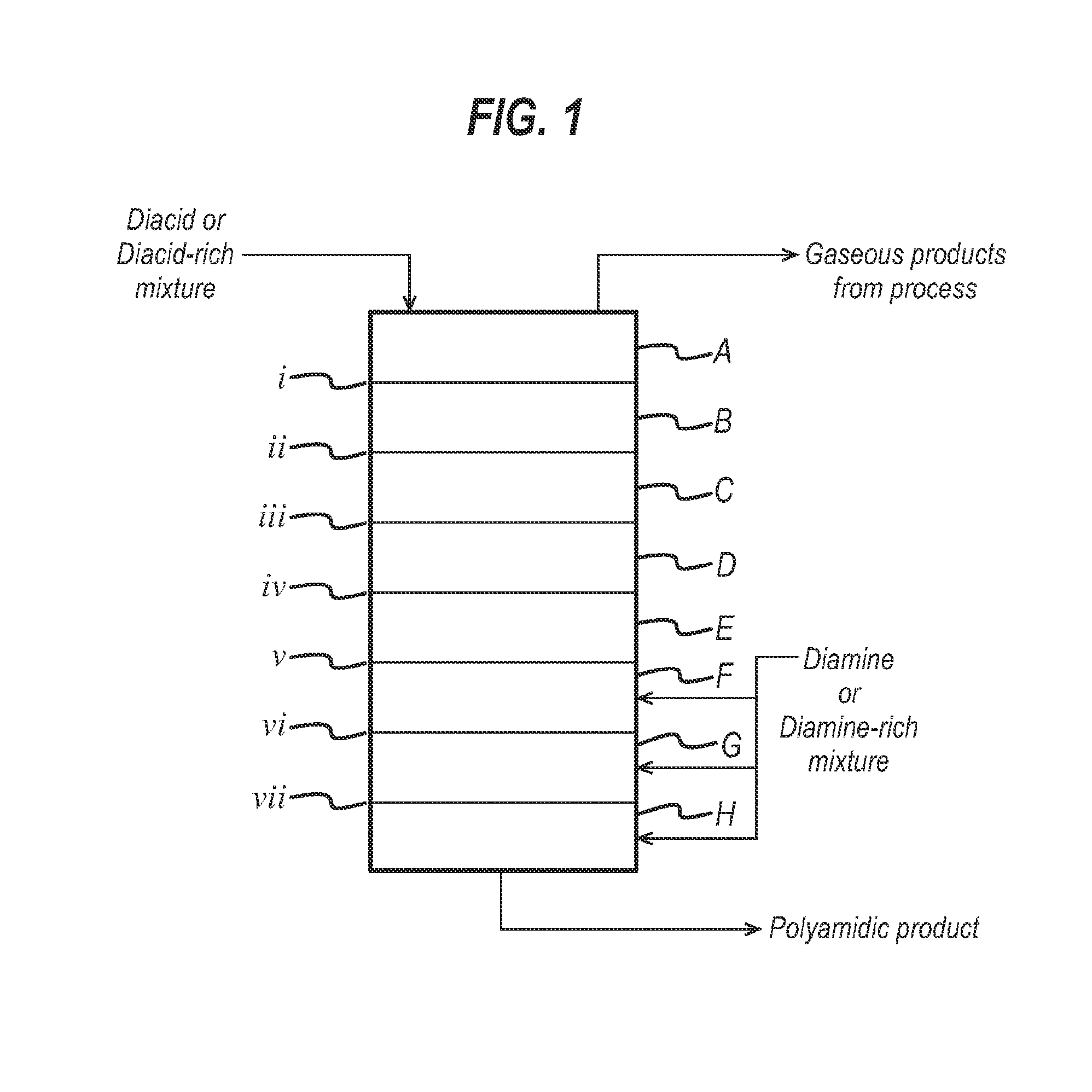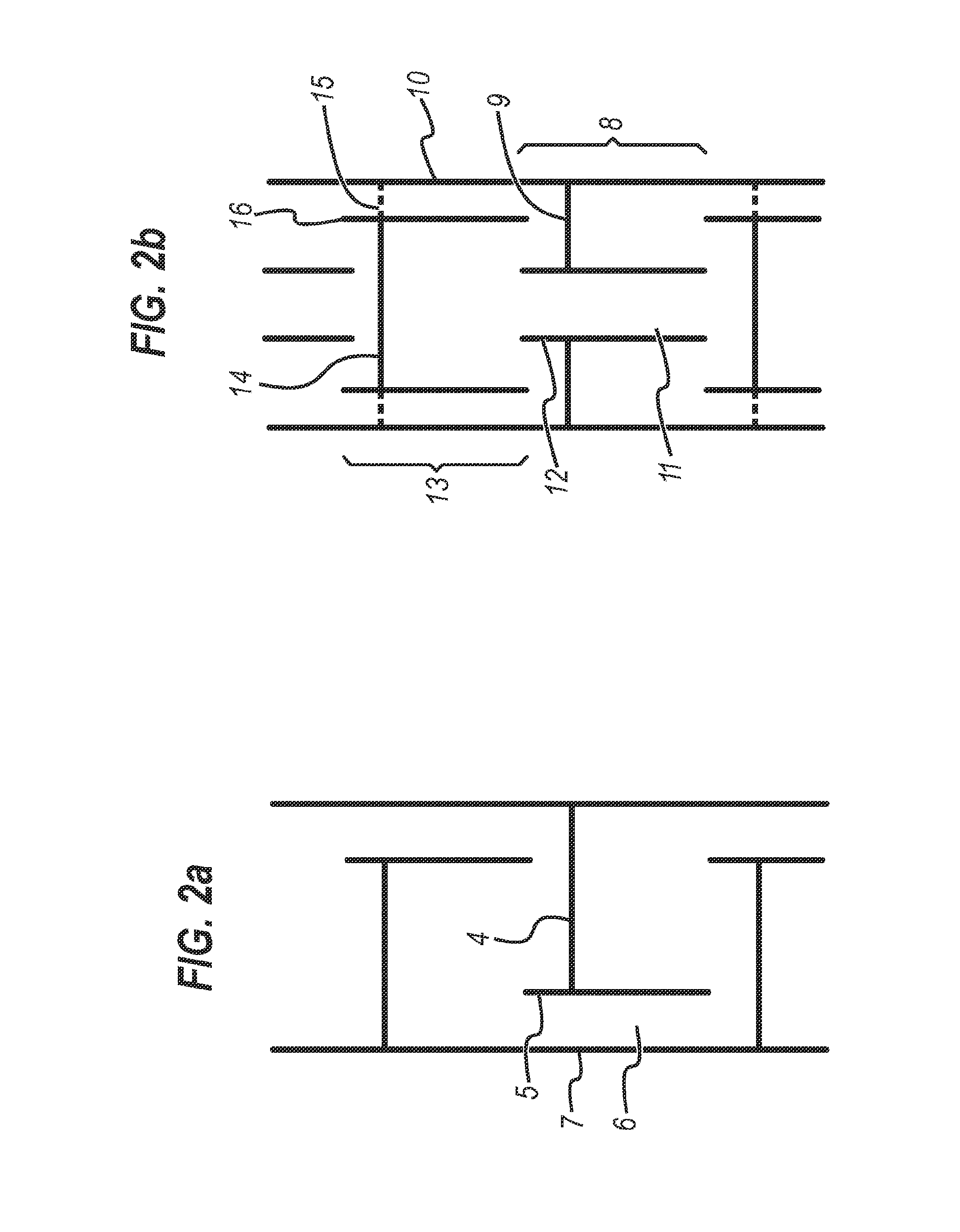Continuous polyamidation process - ii
a polyamide and process technology, applied in the direction of chemical/physical/physical-chemical processes, liquid-liquid reaction processes, chemical apparatus and processes, etc., can solve the problems of reactor complexity and process scale-up complexity, chemical degradation of products, and increase in viscosity and gel build-up, so as to improve reactor size and output, simplify reactor design, and facilitate process scale-up and design
- Summary
- Abstract
- Description
- Claims
- Application Information
AI Technical Summary
Benefits of technology
Problems solved by technology
Method used
Image
Examples
example 1
[0089]Adipic acid (AA) and hexamethylene diamine (HMD) are fed into a mixing tank at 162 lb / hr and 38 lb / hr, respectively. The heated mixture is fed into the top of an eight-stage reactor column at a rate of 199 lb / hr. Gaseous HMD is fed into the lowest three stages of the reactor at a rate of 90 lb / hr. During the reaction process, a stream C of steam is fed from a pressurised plenum at a rate of up to 20 lb / hr into a conical chamber below the lowest stage at the bottom of the reactor, the conical chamber being the region below the lowest stage in which is accumulated liquid phase material P rich in high molecular weight polyamide. The reactor is not equipped with an agitator, but otherwise comprises the features described in FIGS. 3a to 3d.
[0090]During operation of the reactor according to the invention, gaseous steam exits from the top of the reactor at a rate of 40 lb / hr without additional steam from stream C, or 60 lb / hr with additional steam from stream C, wherein the vapour e...
example 2
[0092]The reactor column of Example 1 is run again at a polyamide withdraw rate of 250 lb / hr but the pressure in the reactor column is varied. Pressure is measured in the vent where gaseous material exits the top of the reactor. The moisture content and viscosity of the liquid phase material P in the region below the lowest stage of the column varies as follows:
TABLE 2Difference inPressureRelativeMoistureViscosityEnd-groups(bar)viscosity(wt %)(Poise)(meq / Kg)0.20323.80.0524979.90.50721.10.1217279.80.81119.80.1914079.71.01319.10.2412679.71.57117.80.379979.62.02716.70.508179.53.04014.90.765679.24.05313.61.044079.04.76212.81.253278.8
[0093]As can be seen in Table 2, increasing the pressure above 1 bar reduces the viscosity of the liquid phase material P. Thus, it is evident that in a column where mechanical agitation is required, the mechanical agitation requirement can be reduced by lowering the viscosity of the material P by increasing the pressure in the column reactor. In this partic...
example 3
[0094]The reactor column of Example 1 is run again at a polyamide withdraw rate of 250 lb / hr but the reactor balance in the column is varied. The moisture content and viscosity of the liquid phase material P in the region below the lowest stage of the column varies has follows:
TABLE 3Difference inPressureRelativeMoistureViscosityEnd-groups(bar)viscosity(wt %)(Poise)(meq / Kg)1.01319.10.24126 79.71.01317.30.2491149.5(excess HMD1.01313.50.2439249.3(excess HMD)1.01317.60.2497−99.4(excess AA)1.01314.60.2452−248.8 (excess AA)
[0095]As can be seen in Table 3, having a stoichiometric imbalance of AA and HMD (either excess AA or excess HMD) in the column reactor reduces the viscosity of the material P. Thus, it is evident that in a column where mechanical agitation is required, the mechanical agitation requirement can be reduced by maintaining and imbalance of AA and HMD in the column reactor. In this particular column reactor, the user can attain optimal viscosity without the need for mechani...
PUM
| Property | Measurement | Unit |
|---|---|---|
| pressure | aaaaa | aaaaa |
| pressure | aaaaa | aaaaa |
| pressure | aaaaa | aaaaa |
Abstract
Description
Claims
Application Information
 Login to View More
Login to View More - R&D
- Intellectual Property
- Life Sciences
- Materials
- Tech Scout
- Unparalleled Data Quality
- Higher Quality Content
- 60% Fewer Hallucinations
Browse by: Latest US Patents, China's latest patents, Technical Efficacy Thesaurus, Application Domain, Technology Topic, Popular Technical Reports.
© 2025 PatSnap. All rights reserved.Legal|Privacy policy|Modern Slavery Act Transparency Statement|Sitemap|About US| Contact US: help@patsnap.com



